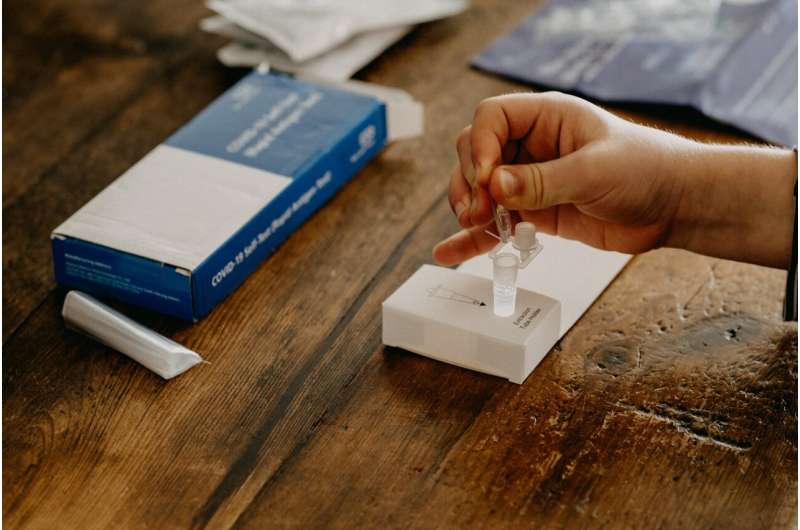
Does the COVID-19 pandemic have a silver lining? A recent article by UMass Chan Medical School and UMass Lowell researchers in Humanities and Social Sciences Communications reports that interest among health care professionals in point-of-care technologies (POCTs) increased during the pandemic, with perceived applications of easy-to-use at-home, mobile or bedside devices in a broader range of diseases.
Health care professionals also viewed the adoption of POCTs as facilitating the humanization of epidemiology—in other words, sharing control of disease diagnosis and management with patients, rather than continuing to be provider-driven.
So-called “gray swan events,” which are expected but unpredictable, can shift attitudes and behaviors, such as about how societies administer and provide access to health care as well as offer unique opportunities to stimulate innovation, the authors wrote. COVID-19 presented one such gray swan opportunity.
“I was trying to understand if there was any sort of positive trajectory that happened as a result of COVID,” said senior author Denise R. Dunlap, Ph.D., associate professor of global strategy, entrepreneurship and innovation at UMass Lowell’s Manning School of Business. “Luckily, we had collected data before COVID hit. And subsequently, we had another survey that was going out during that time period in the pandemic. So, it provided a unique opportunity to study trends pre-and post-COVID.”
Relatively few other studies have looked at factors affecting adoption of POCTs among health care professionals, according to the paper’s authors. COVID-19 provided an opportunity to highlight the weaknesses in health care delivery systems, including a dependence on laboratory-based diagnostic technologies, and to rapidly develop novel technologies to address patient needs.
Dr. Dunlap and her colleagues worked with UMass Chan researchers David D. McManus, MD, the Richard M. Haidack Professor in Medicine and chair and professor of medicine; Nathaniel Hafer, Ph.D., assistant professor of molecular medicine and lead investigator of the National Institute of Health’s (NIH) Rapid Acceleration of Diagnostics (RADx) Tech Clinical Studies Core Logistics Team; Craig M. Lilly, MD, professor of medicine, anesthesiology and surgery; and T.H. Chan School of Medicine fourth-year student Sean Teebagy.
“Point of care was really a backwater for a long time,” said Dr. Hafer. “Now, having the COVID experience, everybody knows what an at-home test is and the benefits of being able to test themselves. So, the conversation has changed from, ‘What the heck is this all about?’ to, ‘How do we apply this now to cancer or other infectious diseases, etc.?'”
In the current study, researchers administered identical surveys to a network of health care professionals, researchers and medical device developers. The first survey was distributed from October 2019 to late March 2020. The second was distributed from late October through November 2020.
Respondents were asked to name up to five conditions for which a POCT could help make a diagnosis of a disease; name up to five conditions for which a POCT could help them monitor or manage a disease; and which characteristics of POCT are most important when incorporating it into their regular practice.
Prior to the COVID-19 pandemic, health care professionals identified 18 medical condition categories for which POCTs could be used to diagnose a disease. Endocrine disorders, including diabetes mellitus, featured prominently among these, followed by infectious disease, cardiovascular and hematology conditions.
Following COVID-19’s designation as a pandemic, health care professionals identified 20 medical conditions for which POCTs could be used to diagnose a disease. Infectious disease and cardiovascular-related medical conditions rose to the center of this network, followed by endocrine, respiratory and hematology conditions.
Perceptions of POCTs to manage or monitor a disease also shifted. Before the pandemic, health care professionals identified cardiovascular disease as the category for which point-of-care technology was most helpful for monitoring or managing. Once COVID-19 was designated a pandemic, endocrine diseases were identified as the condition for which POCT was most useful. However, metabolic diseases experienced the greatest increase in interest.
“I believe there are many different reasons as to why point-of-care technology became more important after COVID; because the more you get used to using a technology, the more you see the benefits of having that technology,” said Dunlap.
Dunlap suggested that during the pandemic, a lot of people with cardiovascular disease or cancer did not get diagnosed because they were afraid to go to the hospital or their health care provider canceled routine screenings.
Source: Read Full Article